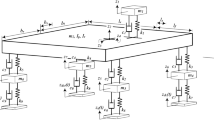Abstract
This study presents the robust design optimization process of suspension system for improving vehicle dynamic performance (ride comfort, handling stability). The proposed design method is so called target cascading method where the design target of the system is cascaded from a vehicle level to a suspension system level. To formalize the proposed method in the view of design process, the design problem structure of suspension system is defined as a (hierarchical) multilevel design optimization, and the design problem for each level is solved using the robust design optimization technique based on a meta-model. Then, In order to verify the proposed design concept, it designed suspension system. For the vehicle level, 44 random variables with 3% of coefficient of variance (COV) were selected and the proposed design process solved the problem by using only 88 exact analyses that included 49 analyses for the initial meta-model and 39 analyses for SAO. For the suspension level, 54 random variables with 10% of COV were selected and the optimal designs solved the problem by using only 168 exact analyses for the front suspension system. Furthermore, 73 random variables with 10% of COV were selected and optimal designs solved the problem by using only 252 exact analyses for the rear suspension system. In order to compare the vehicle dynamic performance between the optimal design model and the initial design model, the ride comfort and the handling stability was analyzed and found to be improved by 16% and by 37%, respectively. This result proves that the suggested design method of suspension system is effective and systematic.
Similar content being viewed by others
Abbreviations
- B i (x):
-
radial basis function
- k :
-
number of design variables
- k i :
-
robust index
- p :
-
preference function
- p i :
-
deviation when bush stiffness is sample
- \(\bar p\) :
-
deviation when bush stiffness is a nominal value
- r i :
-
distance between interpolation point (x) and sampling point
- S(y):
-
sample variance
- w i :
-
weighting coefficient for B i (x)
- \(\tilde z\)(x):
-
the RBF method construction approximation function
- X j (x):
-
polynomial basis function
- a :
-
alpha weight
- β i :
-
coefficient for X j (x)
- σ 0(x):
-
standard deviation
- Ω:
-
design range
- Δ:
-
the deviation represented the uncertainty
References
Choi, B. L., Choi, J. H. and Choi, D. H. (2004). Reliability-based design optimization of an automotive suspension system for enhancing kinematics and compliance characteristics. Int. J. Automotive Technology 6,5, 235–242.
Chun, H. H., Kwon, S. J. and Tak, T. (2007). Reliabilitybased design optimization of automotive suspension systems. Int. J. Automotive Technology 8,6, 713–722.
Cramer, E., Dennis, J., Frank, P., Lewis, R. and Shubin, G. (1994). Problem formulation for multidisciplinary optimization. SIAM J. Optimization, 754–776.
Deo, H. V. and Suh, N. P. (2004). Axiomatic design of automobile suspension and steering systems: Proposal for a novel six-bar suspension. SAE Paper No. 2004-01-0811.
Gerrard, M. B. (2005). The equivalent elastic mechanism: A tool for the analysis and the design of compliant suspension linkages. SAE Paper No. 2005-01-1719.
Heo, S. J. (1998). Vehicle Dynamics. Munohdang. Seoul. Korea.
Hussain, M. F., Barton, R. R. and Joshi, S. B. (2002). Meta modeling: Radial basis functions, versus polynomials. European J. Operational Research, 138, 142–154.
ISO-2631 (1997). Mechanical Vibrationand Shock-Evaluation of Human Exposureto Whole-body Vibration-Part 1: General Requirements. Int. Standards Organization ISO 2631-1.1997 Standard.
ISO-7401 (1988). Road Vehicles-Lateral Transient Response Test Methods. Int. Standards Organization, ISO 7401.
Kang, D. O., Heo, S. J. and Kim, M. S. (2010). Robust design optimization of the McPherson suspension system with consideration of a bush compliance uncertainty. Proc. Institution of Mechanical Engineers, Part D: J. Automobile Engineering, 705–717.
Kim, H. M., Michelena, N. F., Papalambros, P. Y. and Jiang, T. (2003). Target cascading in optimal system design. Trans. ASME J. Mechanical Design, 125, 474–480.
Kim, M. S. (2006). RecurDyn/AutoDesign: Meta-Model Based Design Optimizer. Theoretical Manual. Function Bay.
Kim, M. S. and Choi, D. H. (2001). An efficient dynamic response optimization using the design sensitivities approximated within the estimate confidence radius. KSME Int. J. 15,8, 1143–1155.
Sobieszczanski-Sobieski, J., Agte, J. S. and Sandusky, R. R. Jr. (1998). Bi-Level Integrated System Synthesis (BLISS). National Aeronauticsand Space Administration Technical Manual NASA/TM-1998-208715.
Wang, J. G. and Liu, G. R. (2002). A point interpolation meshless method based on radial basis functions. Int. J. Numer. Meth. Engng., 54, 1623–1648.
Author information
Authors and Affiliations
Corresponding author
Rights and permissions
About this article
Cite this article
Kang, D.O., Heo, S.J., Kim, M.S. et al. Robust design optimization of suspension system by using target cascading method. Int.J Automot. Technol. 13, 109–122 (2012). https://doi.org/10.1007/s12239-012-0010-y
Received:
Revised:
Published:
Issue Date:
DOI: https://doi.org/10.1007/s12239-012-0010-y




